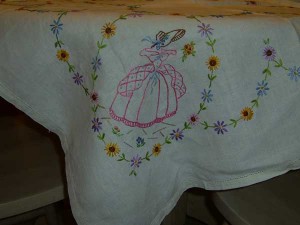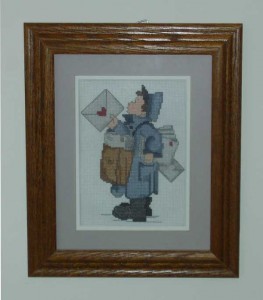Is embroidery dead? Hand embroidery, that is. Yes, we can still buy embroidered items, but has the art of hand stitching with thread and a needle gone the way of the dinosaur?
Embroidery is a craft that has been around since 30,000 BC. The Bayeux Tapestry, which depicted the Norman Invasion in 1066, was embroidered in the 11th century. Sculptures and paintings show inhabitants of ancient civilizations wearing hand-embroidered clothing, often adorned by beads and precious stones. In the 1800’s, embroidery mahines were invented and the art of hand embroidery declined. Still, those who enjoyed the process handed down the skills to future generations.
I don’t remember learning how to embroider so I was obviously really young. But I do know I learned at the feet of women who were masters of the craft – my grandmother and my mother. Even when my grandmother was legally blind, she embroidered this tablecloth for me to cover the table holding my wedding cake. It’s pretty fragile now, but something I’ll always treasure.

I was never as proficient as my grandmother in fine stitching. I could do a mean chain stitch and even a pretty good petal stitch. But a satin stitch – no matter how much I practiced, I couldn’t accomplish a smooth even surface.
In the 70’s, crewel embroidery became popular. Embroidery with yarn. Craft stores were filled with kits containing yarn, stencilled fabric and a numbered pattern to follow. Then came counted cross-stitch. They call it embroidery, but it isn’t really. It’s a matter of making an X in the holes in the Aida cloth.

It’s a shame the art has all but disappeared. Machine embroidery may be fine for now, but where are the heirloom hand-crafted tablecloths and linens to pass down to our children? And what’s worse, they don’t even realize what they’re missing.

I used to embroider, crewel, needlepoint and cross-stich, but it’s harder and harder to find good patterns. Plus the strain on the eyes is hard to deal with.
I’ve switched to crocheting afghans . . . Though I’ve been ripping out a lot of rows recently. Mess up and you don’t catch it until the next row, means a lot of ripping out.
A couple of cross-stitch things that I made were very intricate with 1/4 stitches and color changes within the same stitch–horribly difficult, but it created beautiful pictures.
One I did for my bro was a lighthouse on a rocky coast of Maine with a turbulent sea and gray skys. it took me over a year and I got second place at the Tulsa State Fair. I was beat out by the portrait of Vermeer’s girl wearing a pearl earring.
Margaret, I’m sure it was beautiful. I find cross-stitch is getting harder every year, too. I need one of those magnifying glasses you hang around your neck.
I crochet and knit as well. I’m even finding crocheting dark colours at night is getting tricky, too, if I don’t have enough light.
I didn’t know embroidery was different from cross-stitch. Thanks for teaching me something new. I stay away from needles, since I inevitably end up bleeding, but I did take up crochet about a year ago. I had no idea working with textiles could be so satisfying.
Those are very pretty…That is one thing I never learned how to do…
Tam, technically it’s embroidery because you still use embroidery thread, but since it’s basically putting the thread through existing holes, I don’t think of it as embroidery. Embroidery to me is making the stitches from scratch.
To me, any kind of needlecraft is very relaxing.
Thanks, Savannah. You know, it’s never too late to learn.